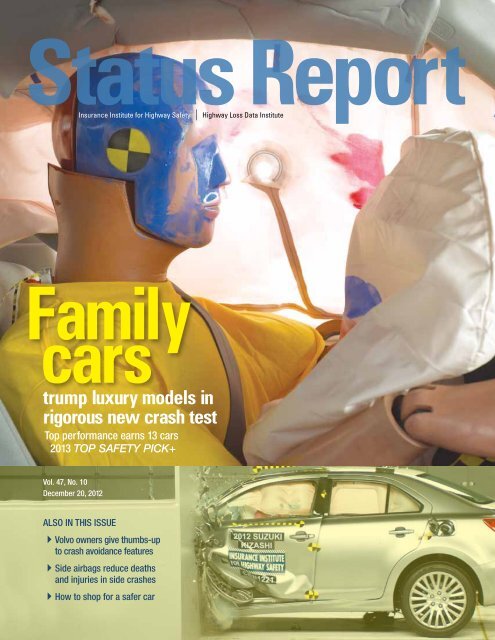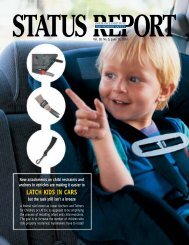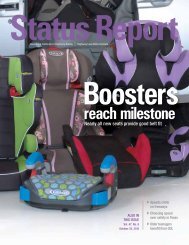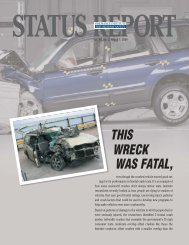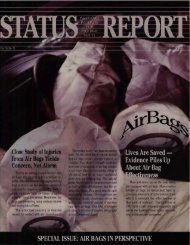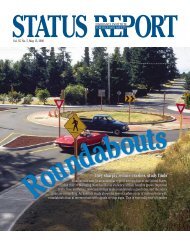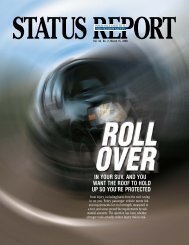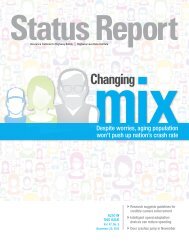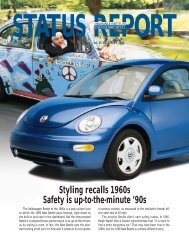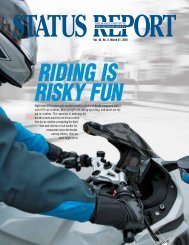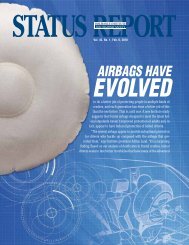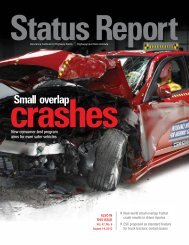IIHS Status Report newsletter, Vol. 47, No. 10, December 20, 2012
IIHS Status Report newsletter, Vol. 47, No. 10, December 20, 2012
IIHS Status Report newsletter, Vol. 47, No. 10, December 20, 2012
You also want an ePaper? Increase the reach of your titles
YUMPU automatically turns print PDFs into web optimized ePapers that Google loves.
<strong>Status</strong> <strong>Report</strong>Insurance Institute for Highway Safety | Highway Loss Data InstituteFamilycarstrump luxury models inrigorous new crash testTop performance earns 13 cars<strong>20</strong>13 TOP SAFETY PICK+<strong>Vol</strong>. <strong>47</strong>, <strong>No</strong>. <strong>10</strong><strong>December</strong> <strong>20</strong>, <strong>20</strong>12Also In this issue4<strong>Vol</strong>vo owners give thumbs-upto crash avoidance features4Side airbags reduce deathsand injuries in side crashes4How to shop for a safer car
The small overlap test evaluates occupant protection in a frontal crash involving 25 percent of acar’s front end. A good or acceptable rating is required to earn the new TOP SAFETY PICK+ award.Agroup of moderately priced midsize cars outperformed mostof their luxury counterparts in a challenging new frontalcrash test conducted by the Insurance Institute for HighwaySafety (<strong>IIHS</strong>) on <strong>20</strong>13 models. Of the 18 midsize family cars evaluatedin the small overlap test, two earn the top rating of good, 11earn acceptable, three earn marginal, and two are poor.In contrast, just 3 of 11 midsize luxury and near-luxury cars evaluatedin the inaugural round of small overlap tests earned goodor acceptable ratings (see <strong>Status</strong> <strong>Report</strong>, Aug. 14, <strong>20</strong>12, at iihs.org).Midsize moderately priced cars are the second group to be tested.Building on its long-running vehicle ratings program for consumerinformation, <strong>IIHS</strong> introduced the small overlap test in <strong>20</strong>12to further improve occupant protection in frontal crashes. Most automakersdesign their vehicles for good performance in the <strong>IIHS</strong>moderate overlap frontal test and the federal government’s fullwidthfrontal test, but many haven’t addressed the problem of smalloverlap crashes. In a <strong>20</strong>09 <strong>IIHS</strong> study of vehicles with good ratingsfor frontal crash protection, small overlap crashes accountedfor nearly a quarter of the frontal crashes involving serious or fatalinjury to front seat occupants (see <strong>Status</strong> <strong>Report</strong>, March 7, <strong>20</strong>09).The small overlap test replicates what happens when the frontcorner of a car collides with another vehicle or an object like a treeor utility pole. In the test, 25 percent of a car’s front end on thedriver side strikes a 5-foot-tall rigid barrier at 40 mph. A 50th percentilemale Hybrid III dummy is belted in the driver seat.“It’s remarkable that this group of midsize family cars did somuch better than the midsize luxury car group,” says Adrian Lund,<strong>IIHS</strong> president. “The difference is stunning. Thirteen of these midsizecars offer better crash protection than all but three of theirluxury counterparts, and at a price that’s easier on the wallet.”New safety awardTo reward <strong>20</strong>13 models with superior crash protection, <strong>IIHS</strong> hascreated the TOP SAFETY PICK+ award, with the + indicating goodor acceptable performance in the new small overlap test. Winnersmust earn good ratings for occupant protection in at least 4of 5 evaluations and no less than acceptable in the fifth test. <strong>IIHS</strong>rates vehicles good, acceptable, marginal or poor based on performancein a moderate overlap frontal crash, small overlap frontalcrash, side impact and rollover test, plus evaluations of seat/head2 |<strong>Status</strong> <strong>Report</strong> — <strong>Vol</strong>. <strong>47</strong>, <strong>No</strong>. <strong>10</strong>
Honda Accordrestraints for protectionagainst neck injuries in rearimpacts.So far, 13 models qualify forthe accolade. Winners include: theDodge Avenger and its twin, the Chrysler<strong>20</strong>0 4-door; Ford Fusion; Honda Accord2-door; Accord 4-door; Kia Optima; Nissan Altima4-door; Subaru Legacy and its twin, the Outback; SuzukiKizashi and <strong>Vol</strong>kswagen Passat. Two previously testedluxury models, the Acura TL and <strong>Vol</strong>vo S60, also earnTOP SAFETY PICK+. <strong>IIHS</strong> will announce additionalwinners as it continues to test models. Results for smallSUVs are expected in the spring.Meanwhile, 117 additional vehicles earn TOP SAFETYPICK for <strong>20</strong>13 (see p. 5). To qualify, vehicles must have goodratings in the moderate overlap frontal test, side impact, rolloverand rear tests, regardless of their small overlap rating.<strong>IIHS</strong> first gave TOP SAFETY PICK to <strong>20</strong>06 models and hastightened criteria twice (see <strong>Status</strong> <strong>Report</strong>, March 24, <strong>20</strong>09).<strong>IIHS</strong> gives manufacturers advance notice of plannedchanges. Automakers in the past have been quick tofactor new <strong>IIHS</strong> evaluations into their designs, and manyare on track to do the same with the introduction of thesmall overlap test and TOP SAFETY PICK+.“We’ve seen automakers make structural and restraintchanges in response to our small overlap test,”Lund says. “Five manufacturers redesigned their midsizecars to enhance small overlap crash protection.”Honda engineered both 2-door and 4-door versionsof the Accord to do well in the test. Ford and NissanMidsize cars’ small overlap frontal ratingsHonda Accord4-doorSuzuki KizashiFord FusionHonda Accord2-doorKia OptimaNissan Altima4-doorNissan MaximaSubaru LegacySubaru OutbackDodge AvengerChrysler <strong>20</strong>04-doorMazda 6<strong>Vol</strong>kswagen PassatHyundai SonataChevrolet Malibu<strong>Vol</strong>kswagen JettasedanToyota CamryToyota Prius vOverallGGAAAAAAAAAAAMMMPPDodge AvengerThe TOP SAFETY PICK+ award goes to<strong>20</strong>13 models that earn good or acceptablein the new small overlap test, in addition togood ratings in at least 4 of 5 evaluationsand no less than acceptable in any test.StructureRestraints &kinematicsMidsize moderatelypriced carsChrysler <strong>20</strong>0 4-doorDodge AvengerFord FusionHonda Accord 2-doorHonda Accord 4-doorKia OptimaNissan Altima 4-doorSubaru LegacySubaru OutbackSuzuki Kizashi<strong>Vol</strong>kswagen PassatDummy injury measuresHead &neckChestHip &thighLower leg& footA G G G G GG A G G G GA A G G G GA A G G G GM G G G G GA G G G G PM G G G G GM G G G G GM G G G G GA M G G G GA M G G G GA M G G G GA M G G G GM A G G G MM M G G G MM M G G G PP P G G G AP P G G P PGood GAcceptableAMidsizeluxury carsAcura TL<strong>Vol</strong>vo S60Marginal MPoorP<strong>December</strong> <strong>20</strong>, <strong>20</strong>12 |3
The key to crash protectionis a strong safety cage thatpreserves occupant survivalspace. Then restraintsystems can cushion andSuzuki Kizashiprotect people.Toyota Prius vToyota Prius vIt’s easy to see why the Suzuki Kizashi earns agood rating for structure. There was only minorintrusion into the occupant compartment. Incontrast, survival space for the driver in theToyota Prius v was seriously compromised.The side curtain airbag also deployed toolate in the crash to offer any protection.made running structural changes to <strong>20</strong>13models already in production. Likewise,Subaru and <strong>Vol</strong>kswagen changed airbagcontrol modules on the production lineso side curtain airbags would deploy forimproved head protection.Toyota falls shortShoppers looking for a midprice familycar will recognize some perennial bestsellerson the TOP SAFETY PICK+ list,including the Accord, Altima and Fusion.One nameplate they won’t find isToyota. The Camry, which is the top-sellingmidsize car in the United States, andthe Prius v, a 4-door hybrid wagon, earnpoor ratings for small overlap protectionand are the worst performers of the midsizegroup. The Camry was redesignedfor <strong>20</strong>12, and the Prius v was an all-newmodel for <strong>20</strong>12.The Camry and Prius v illustrate whatcan go wrong in a small overlap crash,despite good ratings in <strong>IIHS</strong> tests thatqualify the cars for TOP SAFETY PICK.Most modern cars have safety cagesbuilt to withstand head-on collisionsand moderate overlap frontal crasheswith little deformation, and the two Toyotasare no exception. Crush zones helpmanage crash energy to reduce forces onthe occupant compartment. The maincrush-zone structures are concentrated inthe middle 50 percent of the front end.When a crash involves these structures,the occupant compartment is protectedfrom intrusion, and front airbags andsafety belts can effectively restrain andprotect people inside.For many vehicles, a 25 percent overlapfrontal impact misses the primary structuresdesigned to manage crash energyand results in crash forces going directlyinto the wheel, suspension system andfirewall. Such crashes often have highlevels of occupant compartment intrusion.It is not uncommon for the wheelto be forced rearward into the footwell,contributing to even more intrusion inthe occupant compartment and resultingin serious leg and foot injuries. Sincethe impact occurs toward the car’s outeredge, the vehicle has a tendency to rotateduring the collision, resulting in the driver’shead moving outboard, away fromthe frontal airbag. Real crashes of thistype result in head injuries from contactwith outboard structures or intrudingobjects such as trees or poles.In the Camry, the force of the impactshoved the front wheel back into thefootwell, bending the windshield pillarand pushing the parking brake pedaland the left outer edge of the instrumentpanel rearward into the driver’s survivalspace. Likewise, there was significant intrusionin the Prius v, along with highforces on the dummy’s legs and feet. ThePrius v is the only car in the midsize testgroup to earn a poor rating for hip andthigh protection.The Camry’s driver airbag and sidecurtain airbag deployed, but the steeringwheel moved so far to the right that thedummy’s head made only minimal contactwith the front airbag. The side curtainairbag didn’t extend far enough forwardto help prevent the dummy’s head fromhitting the instrument panel. In the Prius v,the side curtain airbag deployed too latein the crash to offer protection.“Toyota engineers have a lot of workto do to match the performance of theircompetitors,” Lund says.Demanding crashThe small overlap frontal test representsa severe crash. When cars strike the testbarrier they tend to move sideways awayfrom it, and the interior structures includingthe driver door, side window andwindshield pillar move in the same direction.The dummy, however, continues forwardinto the path of the sideways-movinginterior structures. At the same time, thesteering column and driver airbag moveinboard in many vehicles as the front endand occupant compartment deform. Ifthe dummy misses the airbag or slides offit, its head and chest are unprotected.Front airbags are calibrated to deployin these crashes. Side airbags, especiallyhead-protecting curtains, don’t alwaysdeploy because they are designed mainlyfor direct side impacts. When they dodeploy, they don’t always do so earlyenough or extend far enough forward toadequately protect people.Without airbags, people in small overlapfrontal crashes can sustain head injuriesfrom direct contact with the windshieldpillar, dashboard or window sill or by4 |<strong>Status</strong> <strong>Report</strong> — <strong>Vol</strong>. <strong>47</strong>, <strong>No</strong>. <strong>10</strong>
hitting trees, poles or other objects. Chest injurieshappen when people contact the steeringwheel, door or other intruding structures.The Accord sedan shows how safety beltsand airbags work together to provide exemplaryprotection. The dummy stayedengaged with the Accord’s front airbag,and the steering wheel remained relativelystable because there was only moderate intrusioninto the occupant compartment.That meant that the driver airbag was in theright position to cushion the dummy’s headand chest. The side curtain airbag extendedfar enough forward to prevent the dummy’shead from hitting interior components.Every midsize car evaluated earns goodratings for head, neck and chest injury riskbased on measurements from dummy sensors.Similar real-world crashes, however,often result in serious upper body injuries.“The dummy doesn’t always tell us everything,”Lund says. “The crash damage in thesetests is like the damage we see in real-worldcrashes where heads and chests are injured.”Unexpected outcomesIn the Jetta test, engineers at the VehicleResearch Center witnessed a first for <strong>IIHS</strong>crash testing when the driver airbag moduledetached from the steering column. It happenedrelatively late in the crash and didn’taffect the dummy’s movement. Still, airbagsshould stay in place in crashes, so engineershad to lower the restraints and kinematicsscore for the marginal-rated Jetta. <strong>IIHS</strong>isn’t aware of a problem with <strong>Vol</strong>kswagen’sairbag module in real-world crashes, and<strong>Vol</strong>kswagen is investigating further.The Kizashi’s results also are unique. Thecar, which Suzuki introduced in the <strong>20</strong><strong>10</strong>model year, is the only midsize moderatelypriced car to earn a good rating forstructure in the small overlap test. The Kizashialso earns good ratings in the moderateoverlap frontal test, side test and seat/head restraint evaluation. Its roof strengthrating, however, is acceptable, so it hasnever qualified for TOP SAFETY PICK.“The Kizashi is a rare case. Its good smalloverlap test performance outweighs its acceptablerollover rating, so the car is a TOPSAFETY PICK+. So far this is the onlymodel we have evaluated to be in this situation,”Lund explains. Suzuki Motor Corp.in <strong>No</strong>vember said it would stop selling carsin the United States. nMinicarsFiat 500Ford FiestaHonda FitNissan Versa sedanToyota Yaris 4-doorSmall carsAcura ILXChevrolet Cruze,Sonic, <strong>Vol</strong>tDodge DartFord FocusHonda Civic 4-doorHonda CR-Z, InsightHyundai ElantraKia Forte sedanKia SoulLexus CT <strong>20</strong>0hMazda 3Mini CooperCountrymanMitsubishi Lancerexcept Ralliart andEvolution modelsNissan Cube, JukeScion FR-S, tC, xDSubaru BRZ, Impreza,XV CrosstrekToyota Corolla,Prius, Prius c<strong>Vol</strong>kswagen Golfonly 4-door models<strong>Vol</strong>kswagen GTIonly 4-door modelsMidsize moderatelypriced carsAudi A3Buick VeranoChevrolet MalibuHyundai SonataToyota Camry, Prius v<strong>Vol</strong>kswagen Jetta sedan<strong>Vol</strong>kswagen JettaSportWagen<strong>Vol</strong>vo C30Midsize luxury/near luxury carsAcura TSXAudi A4 sedanBMW 3 Seriesonly sedansLexus ESMercedes C-Class<strong>Vol</strong>kswagen CCexcept 4-wheel drive V6Large family carsBuick LaCrosse, RegalChrysler 300Dodge ChargerFord TaurusHyundai AzeraToyota AvalonLarge luxury carsAudi A6BMW 5 Seriesexcept 4-wheel drive and V8Cadillac CTSonly sedansCadillac XTSHyundai Equus, GenesisLexus GSLincoln MKSMercedes E-Class 2-doorMercedes E-Class 4-door<strong>Vol</strong>vo S80Small SUVsFord EscapeHonda CR-VHyundai TucsonJeep Patriotwith optional side torso airbagsKia SportageMazda CX-5Mitsubishi OutlanderSportSubaru Forester<strong>Vol</strong>kswagen TiguanMidsize SUVsChevrolet EquinoxDodge Durango, JourneyFord Edge, Explorer, FlexGMC TerrainHonda Crosstour, PilotHyundai Santa FeJeep Grand CherokeeKia SorentoSubaru TribecaToyota 4Runner,Highlander, VenzaMidsize luxury SUVsAcura MDX, RDXAudi Q5BMW X3Cadillac SRXInfiniti EXLexus RXLincoln MKT, MKXMercedes GLK, M-Class<strong>Vol</strong>vo XC60, XC90Mazda CX-5Chevrolet SonicLarge SUVsBuick EnclaveChevrolet TraverseGMC Acadia<strong>Vol</strong>kswagenTouaregMinivansChrysler Town &CountryDodge GrandCaravanHonda OdysseyToyota Sienna<strong>Vol</strong>kswagenRoutanLarge pickupsFord F-150crew cab modelsHonda RidgelineToyota Tundracrew cab modelsTOP SAFETY PICK recognizes vehiclesthat do the best job of protectingpeople in moderate overlap frontal,side, rollover and rear crashes basedon good ratings in <strong>IIHS</strong> evaluations.<strong>December</strong> <strong>20</strong>, <strong>20</strong>12 |5
<strong>Vol</strong>vo owners give thumbs-upto crash avoidance featuresOwners of <strong>Vol</strong>vos with advanced crash avoidance features findthe systems useful, and the vast majority would want the technologyagain, an <strong>IIHS</strong> survey shows. The positive results are inline with an earlier survey (see <strong>Status</strong> <strong>Report</strong>, <strong>No</strong>v. 18, <strong>20</strong>09, at iihs.org). This time, the participants were not limited to the early adoptersquestioned several years ago, when the technology was new.Researchers interviewed nearly 500 owners of <strong>Vol</strong>vo models withcrash avoidance features. Some had City Safety, a low-speed forwardcollision avoidance system standard on certain models; some had anoptional technology package that includes forward collision warning,lane departure warning and other features; and some had both.“The majority of these drivers told us they like the crash avoidancetechnology in their vehicles,” says Anne McCartt, senior vice presidentfor research at <strong>IIHS</strong>. “For the most part they are taking advantageof the systems, and many credit them with preventing crashes.”Based on insurance data, these systems appear to be reducingcrashes. The Highway Loss Data Institute (HLDI) has found that therate of property damage liability claims for <strong>Vol</strong>vos with standard CitySafety is lower than for other vehicles in the same class and for <strong>Vol</strong>voswithout the technology (see <strong>Status</strong> <strong>Report</strong>, July 19, <strong>20</strong>11). HLDI alsofound lower claim frequencies with the optional technology package,which includes a higher-speed forward collision warning system withautonomous braking, adaptive cruise control, distance alert, lane departurewarning and fatigue warning (see <strong>Status</strong> <strong>Report</strong>, July 3, <strong>20</strong>12).Drivers’ reactions are important because many systems provideonly warnings and require drivers to take action. And most featurescan be deactivated, so the technologies needto be accepted to be effective.Among the respondents with the optional technology package,about half said they always used adaptive cruise control, which maintainsa set following distance, on high-speed roads. Eighty-nine percentsaid that when adaptive cruise control is not in use they alwaysdrive with distance alert, which warns the driver if the vehicle is gettingtoo close to one in front but, unlike adaptive cruise control, doesn’taffect vehicle speed. The same number said they leave forward collisionwarning on at all times, while fewer than two-thirds always drivewith lane departure warning. Of the respondents with City Safety, 78percent always drive with the system on. Eighteen percent said theyweren’t aware they had City Safety. It is likely those people also weredriving with the system activated, since the default is “on.”The lower use rate for lane departure warning may be relatedto the annoyance factor: One-third of respondents said theyfound the feature’s warning chime annoying. Drifting slightly overa lane marking is a common occurrence, and some drivers are accustomedto exiting, merging or changing lanes without signaling,which would trigger the warning. The system also can be triggeredby things like old lane markings in construction zones.The earlier <strong>IIHS</strong> survey, which involved owners of <strong>Vol</strong>vo and Infinitivehicles with crash avoidance features, also found that fewerdrivers kept lane departure warning on at all times than other features.In that survey, a quarter of <strong>Vol</strong>vo owners and 41 percent ofInfiniti owners found lane departure warning annoying. The tendencyto turn off the system seems to have grown: Among the firstgroup, 69 percent of <strong>Vol</strong>vo owners said they always drove with lanedeparture warning, compared with 59 percent in the new survey.In the current study, most owners reported experiencing activationsof lane departure warning, forward collision warning andfatigue warning. Thirty-seven percent said they experienced autonomousbraking, including City Safety. Many respondents said theybelieved the features had helped prevent crashes. For example, 45percent of those who had driven with forward collision warningsaid the alerts from that feature had helped them avoid a crash.Warnings perceived as false or unnecessary were reported by 37percent of owners for forward collision warning and 33 percent for<strong>IIHS</strong> is evaluating City Safety and other crash avoidance systems at its Vehicle Research Center. HLDI analysis ofclaims for <strong>Vol</strong>vos with City Safety indicates the system is reducing crashes. <strong>Vol</strong>vo owners say they like the features.6 |<strong>Status</strong> <strong>Report</strong> — <strong>Vol</strong>. <strong>47</strong>, <strong>No</strong>. <strong>10</strong>
<strong>10</strong>0%80%60%40%<strong>20</strong>%0%lane departure warning. Unnecessary autonomous braking wasn’tas commonly reported at 14 percent.For each feature, more than 80 percent of respondents said theywould want the system again on their next vehicle.While the responses are similar to the earlier survey, this updateshows positive reactions weren’t limited to drivers who eagerlysnapped up a brand new safety technology. The first survey involved<strong>Vol</strong>vos from <strong>20</strong>08, the first model year that both forwardcollision warning and lane departure warning were offered as options.The current study involves <strong>20</strong><strong>10</strong>-12 <strong>Vol</strong>vos and is the firstto look at City Safety, which, because it comes standard, could bemore likely to include respondents whose attitude toward safety issimilar to the average driver.Percentage of owners who drive with crash avoidance systems onPercentage of owners who want system on next vehicleAmong current owners of each system<strong>10</strong>0%80%60%40%<strong>20</strong>%0%Distance alertAdaptivecruisecontrolForwardcollision warningCity SafetyLanedeparture warningdon’t know never sometimes alwaysDistance Forwardalert collisionwarningwith auto brakeCitySafetyFatiguewarningLanedeparturewarning“While lane departure warning lags behind other technologiesin the percentage of drivers who use it all the time, all these featuresare proving to be popular with a majority of drivers,” McCarttsays. “That bodes well for the future of crash avoidance. With moredriver interest, more manufacturers should understand that it paysto invest in these systems and will offer them in more vehicles.”For a copy of “<strong>Vol</strong>vo drivers’ experiences with advanced crashavoidance and related technologies” by A.H. Eichelberger and A.T.McCartt, email publications@iihs.org. nCombination side airbagsreduce death and injury riskSide airbags that protect the head and torso reduce the likelihoodof death and upper body injuries to passenger vehicledrivers in near-side crashes by 61 percent compared with noside airbags. This is the main finding of a new study by the MonashUniversity Accident Research Centre.The Victoria, Australia, study reinforces prior research on the effectivenessof side airbags that protect people’s heads and torsos incrashes. A <strong>20</strong>06 study by the Insurance Institute for Highway Safety(<strong>IIHS</strong>) found that side airbags with head protection reduce a cardriver’s risk of death in a near-side crash by an estimated 37 percentand an SUV driver’s risk by 52 percent (see <strong>Status</strong> <strong>Report</strong>, Oct.7, <strong>20</strong>06, at iihs.org).Monash University researchers matched police reports of <strong>20</strong>01-09driver-side crashes in Victoria, Australia, with insurance injuryclaims data to look specifically at injuries to body regions directlyrelevant to side airbags.The researchers found a 51 percent reduction in the odds of deathand injury to all body regions and a 53 percent reduction in death andinjury risk to the head, neck and face in vehicles equipped with headand-torso-protectingside airbags. In comparison, researchers foundthat side airbags designed to protect only a person’s torso didn’t provideany statistically significant injury reductions. This finding differsfrom research by <strong>IIHS</strong> showing that torso-only side airbags reduce fatalityrisk by 26 percent for car drivers and 30 percent for SUV drivers.Under the Australasian New Car Assessment Program (ANCAP),vehicles must have head-protecting side airbags for the driver andfront passenger in order to earn the maximum 5-star safety rating.Starting in <strong>20</strong>14, second-row seats must have side airbags, too.The U.S. government doesn’t mandate side airbags specificallybut does require a high level of head and torso protection for all occupantsin side crashes. In <strong>IIHS</strong> crash tests assessing protection in aside impact, all of the vehicles that perform well are equipped withhead-protecting side airbags.For a copy of “Evaluation of vehicle side airbag system effectiveness”by A. D’Elia et al. go to www.monash.edu.au/miri/research/reports/muarc312.html nShopping for a Safer Car brochurehelps buyers home in on best choicesSelecting a safer vehicle is a lot easierthan it used to be. Most new cars, minivans,pickup trucks and SUVs earn goodratings in front and side crash tests. Somemodels still need improvement when itcomes to protecting people in rollovers andrear crashes. This <strong>IIHS</strong> publication explainsthe features safety-conscious consumersshould consider. Go to iihs.org/brochuresfor a digital copy. For print brochures, emailpublications@iihs.org.<strong>December</strong> <strong>20</strong>, <strong>20</strong>12 |7
<strong>Status</strong> <strong>Report</strong>Midsize family cars trump luxury models inrigorous new small overlap crash test42<strong>Vol</strong>vo owners give thumbs-up to crashavoidance features46Side airbags reduce deaths and injuries<strong>47</strong>How to shop for a safer car<strong>47</strong><strong>Vol</strong>. <strong>47</strong>, <strong>No</strong>. <strong>10</strong><strong>December</strong> <strong>20</strong>, <strong>20</strong>12<strong>10</strong>05 N. Glebe RoadArlington, VA 22<strong>20</strong>1 USAt 703/2<strong>47</strong>-1500f 703/2<strong>47</strong>-1588Inquiries/print subscriptions:<strong>Status</strong><strong>Report</strong>@iihs.orgCopy may be republished withattribution. Images requirepermission to use.Editor: Kim StewartWriter: Sarah KarushArt Director: Steve Ewenswww.iihs.orgiihs.org/rssyoutube.com/iihs@<strong>IIHS</strong>_autosafetym.iihs.orgThis publication is printed on recycled paper.The Insurance Institute for Highway Safety is an independent, nonprofit scientific and educational organization dedicatedto reducing the losses — deaths, injuries and property damage — from crashes on the nation’s roads.The Highway Loss Data Institute shares and supports this mission through scientific studies of insurance data representingthe human and economic losses resulting from the ownership and operation of different types of vehicles and by publishinginsurance loss results by vehicle make and model.Both organizations are wholly supported by the following auto insurers and funding associations:Member groupsAcceptance InsuranceACE Private Risk ServicesAffirmative InsuranceAgency Insurance Company of MarylandAlfa Alliance Insurance CorporationAlfa InsuranceAllstate Insurance GroupAmerican Family Mutual InsuranceAmerican National Family of CompaniesAmeriprise Auto & HomeAmica Mutual Insurance CompanyARI Insurance CompaniesAuto Club EnterprisesAuto Club GroupBankers Insurance GroupBituminous Insurance CompaniesCalifornia Casualty GroupCalifornia State Auto GroupCapital Insurance GroupChubb & SonColorado Farm Bureau Mutual Insurance CompanyCommonwealth Mutual Insurance Company of AmericaConcord Group Insurance CompaniesCotton States InsuranceCOUNTRY FinancialDallas National Insurance CompanyDirect General CorporationDiscovery Insurance CompanyDriver’s Insurance GroupErie Insurance GroupEsuranceFarm Bureau Financial ServicesFarm Bureau Insurance of MichiganFarm Bureau Mutual Insurance Company of IdahoFarmers Insurance Group of CompaniesFarmers Mutual Hail Insurance Company of IowaFarmers Mutual of NebraskaFireman’s Fund Insurance CompanyFlorida Farm Bureau Insurance CompaniesFrankenmuth InsuranceGainsco InsuranceGEICO GroupGeorgia Farm Bureau Mutual Insurance CompanyGMAC Personal Lines InsuranceGoodville Mutual Casualty CompanyGrange InsuranceHallmark Insurance CompanyHanover Insurance GroupThe HartfordHaulers Insurance Company, Inc.Homeowners of America Insurance CompanyHorace Mann Insurance CompaniesICW GroupImperial Fire & Casualty Insurance CompanyIndiana Farmers Mutual Insurance CompanyInfinity Property & CasualtyKemper PreferredKentucky Farm Bureau InsuranceLiberty Mutual Insurance CompanyLouisiana Farm Bureau Mutual Insurance CompanyMaryland Automobile Insurance FundMercury Insurance GroupMetLife Auto & HomeMiddleOakMississippi Farm Bureau Casualty Insurance CompanyMMG InsuranceMutual of Enumclaw Insurance CompanyNationwideNew Jersey Manufacturers Insurance GroupNLC Insurance Companies, Inc.<strong>No</strong>dak Mutual Insurance Company<strong>No</strong>rfolk & Dedham Group<strong>No</strong>rth Carolina Farm Bureau Mutual Insurance Company<strong>No</strong>rthern Neck Insurance CompanyOld American County Mutual Fire InsuranceOld American Indemnity CompanyOregon Mutual InsurancePekin InsurancePEMCO InsurancePlymouth Rock AssuranceProgressive CorporationThe Responsive Auto Insurance CompanyRockingham GroupSafeco InsuranceSamsung Fire & Marine Insurance CompanySECURA InsuranceSentry InsuranceShelter InsuranceSompo Japan Insurance Company of AmericaSouth Carolina Farm Bureau Mutual Insurance CompanySouthern Farm Bureau Casualty Insurance CompanyState Auto Insurance CompaniesState FarmTennessee Farmers Mutual Insurance CompanyTexas Farm Bureau Insurance CompaniesTower Group CompaniesThe Travelers CompaniesUnited EducatorsUSAAUtica National Insurance GroupVirginia Farm Bureau Mutual InsuranceWest Bend Mutual Insurance CompanyYoung America Insurance CompanyZurich <strong>No</strong>rth AmericaFunding associationsAmerican Insurance AssociationNational Association of Mutual Insurance CompaniesProperty Casualty Insurers Association of America


